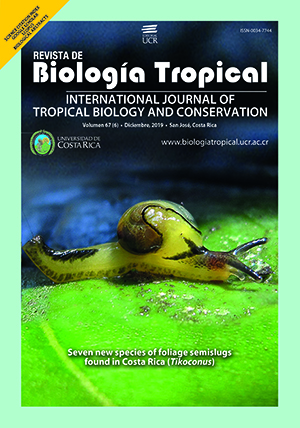Abstract
Lygodium sp. is a climbing fern that occurs in open forests, settling frequently in areas with disturbed vegetation. In Argentina, Lygodium venustum inhabits in the protected area "Moconá" Provincial Park, in few and small populations. In-vitro cultivation of spores is a strategy for ex-situ conservation of species with reduced or threatened populations. Usually, fern spores need to be surface sterilized before sowing, to avoid the development of unwanted microorganisms. As part of our project focused on the conservation of native fern species in Argentina, the aim of this work was to evaluate a propagation protocol for L. venustum through in-vitro cultivation of spores, employing a standard procedure of disinfection, to investigate its effect on spore germination and the subsequent gametophyte as well as its response by the inoculation with a fungus. A batch of spores was previously treated with 10% (v/v) solution of NaOCl during 2 min and then sown in Dyer agar medium supplemented with 1% Nystatin (T1). The petri dishes were incubated in a growth chamber under white illumination (28μmol m-2 s-1) with a photoperiod of 12 hr and a temperature of 22±2°C. Another set of spores without previous disinfection was sown on Dyer agar medium and under the same conditions and used as a control (T0). Spore germination and gametophyte and sporophyte development were monitored through periodical observations under stereoscopic and light microscopes. As during cultures of non-disinfected spores a fungus developed in association with L. venustum gametophytes, its conidia were morphologically characterized as well as those obtained from the black spots present on the sporophyte leaves. A conidial suspension was applied to 20 days-old gametophytes obtained in axenic conditions to evaluate the appearance of any symptom. In both treatments (T1 and T0), spores germinated at 7 days after sowing. The pattern of spore germination followed the Anemia-type, unlike the Vittaria-type found by other researchers. Untreated spores showed a higher mean percentage of germination than those treated (86 and 72 % in 30 days, respectively). In T0 gametophytes grew in association with a fungus, whose conidia had the morphological characteristics of Pestalotiopsis maculans, as occurred with the conidia obtained from the black spots of L. venustum leaves. The association of P. maculans with L. venustum is reported here for the first time. The gametophytes developed in T0 and those inoculated with P. maculans became necrotic and died before producing gametangia, suggesting a pathogenic role of the fungus. The elevated percentage of spore germination registered in T0 could also indicate some effect of P. maculans or its metabolites in the promotion of spore germination. Gametophytes developed in T1 became bisexual or unisexual male, which points to the presence of some antheridiogen that induces the production of antheridia on smaller or slower-growing gametophytes. The sporophytes arose after 4 months of spore sown in T1, pointing out the methodology employed here suitable for the ex-situ conservation of L. venustum.
##plugins.facebook.comentarios##

This work is licensed under a Creative Commons Attribution 4.0 International License.
Copyright (c) 2019 Juliera Bejar, Mónica A. Murace, Mario Carlos Saparrat






